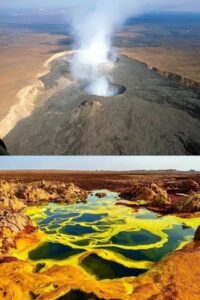
Uganda Today Edition:The Danakil Desert: Earth’s Hottest and Most Extreme Region
Located in northeastern Ethiopia, the Danakil Desert stands as one of the most inhospitable and extreme regions on the planet. Its unique geological features, extraordinary landscapes, and harsh environmental conditions make it a place of great interest to scientists and adventurers alike. Here’s an in-depth look at what makes the Danakil Desert so remarkable.
Extreme Climate
The Danakil Desert is notorious for its extreme climate. With temperatures regularly exceeding 50°C (122°F), it is one of the hottest places on Earth. The relentless heat and arid conditions create a landscape where survival is a constant challenge. Despite these extreme temperatures, the desert supports a unique ecosystem adapted to its harsh environment.
Volcanic and Geothermal Activity
One of the most fascinating aspects of the Danakil Desert is its intense volcanic and geothermal activity. The region is home to several volcanoes, including the famous Erta Ale, which boasts a permanent lava lake. This lava lake, one of only a few in the world, offers a spectacular and rare glimpse into the Earth’s fiery interior. Additionally, the desert features numerous geysers and hot springs, contributing to its dynamic and ever-changing landscape.
“Street Reactions: Which Country Do You Think is the Poorest in the World?”
Salt Depressions
The Danakil Desert is also known for its vast salt depressions. The most notable of these is the Danakil Depression, one of the lowest points on Earth, lying approximately 125 meters below sea level. This area is characterized by expansive salt plains and unique salt formations, which have been harvested for centuries. The salt mining industry remains a crucial part of the local economy, providing a livelihood for the desert’s inhabitants.
Acid Lakes and Colored Waters
In the Dallol region of the Danakil Desert, visitors can witness some of the most surreal and vibrant landscapes on the planet. Here, acid lakes and mineral formations display bright colors due to the high concentration of salts and minerals. The striking hues of yellow, green, and red create otherworldly scenes that seem more akin to a science fiction movie than reality. These acid lakes, with their extreme acidity and mineral content, are a testament to the harsh and unusual conditions that define the Danakil Desert.
The Afar Population
Despite its extreme environment, the Danakil Desert is home to the resilient Afar people. This indigenous group has adapted their lifestyle to the harsh desert conditions, maintaining traditions and cultural practices that have endured for generations. The Afar are particularly known for their salt collection activities, which involve extracting and transporting salt from the desert’s vast salt flats. This traditional practice is not only an economic necessity but also a significant cultural heritage.
Adapted Biodiversity
Life in the Danakil Desert is scarce but remarkably adapted to the extreme conditions. The desert hosts a variety of extremophiles—organisms that thrive in environments with extreme heat and salinity. These life forms are of significant interest to scientists studying the limits of life on Earth and the potential for life in similar extreme environments on other planets.
A Place of Great Interest
The Danakil Desert, with its combination of extreme climate, volcanic activity, unique geological formations, and adapted biodiversity, remains a place of great scientific and adventurous interest. Its extraordinary landscapes and environmental challenges offer a unique window into some of the most extreme conditions found on our planet. For those daring enough to venture into this harsh environment, the Danakil Desert promises an experience unlike any other, revealing the incredible resilience of both nature and humanity.
By exploring and understanding regions like the Danakil Desert, we gain valuable insights into the Earth’s natural processes, the adaptability of life, and the enduring spirit of the people who call this extreme environment home.
